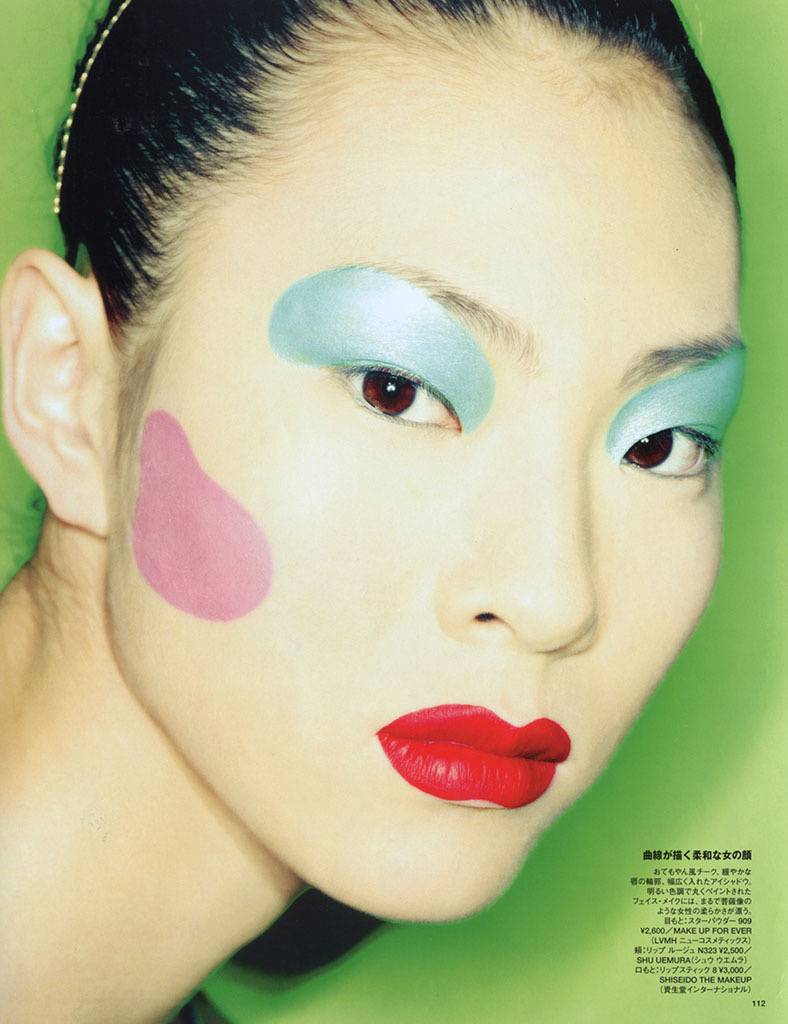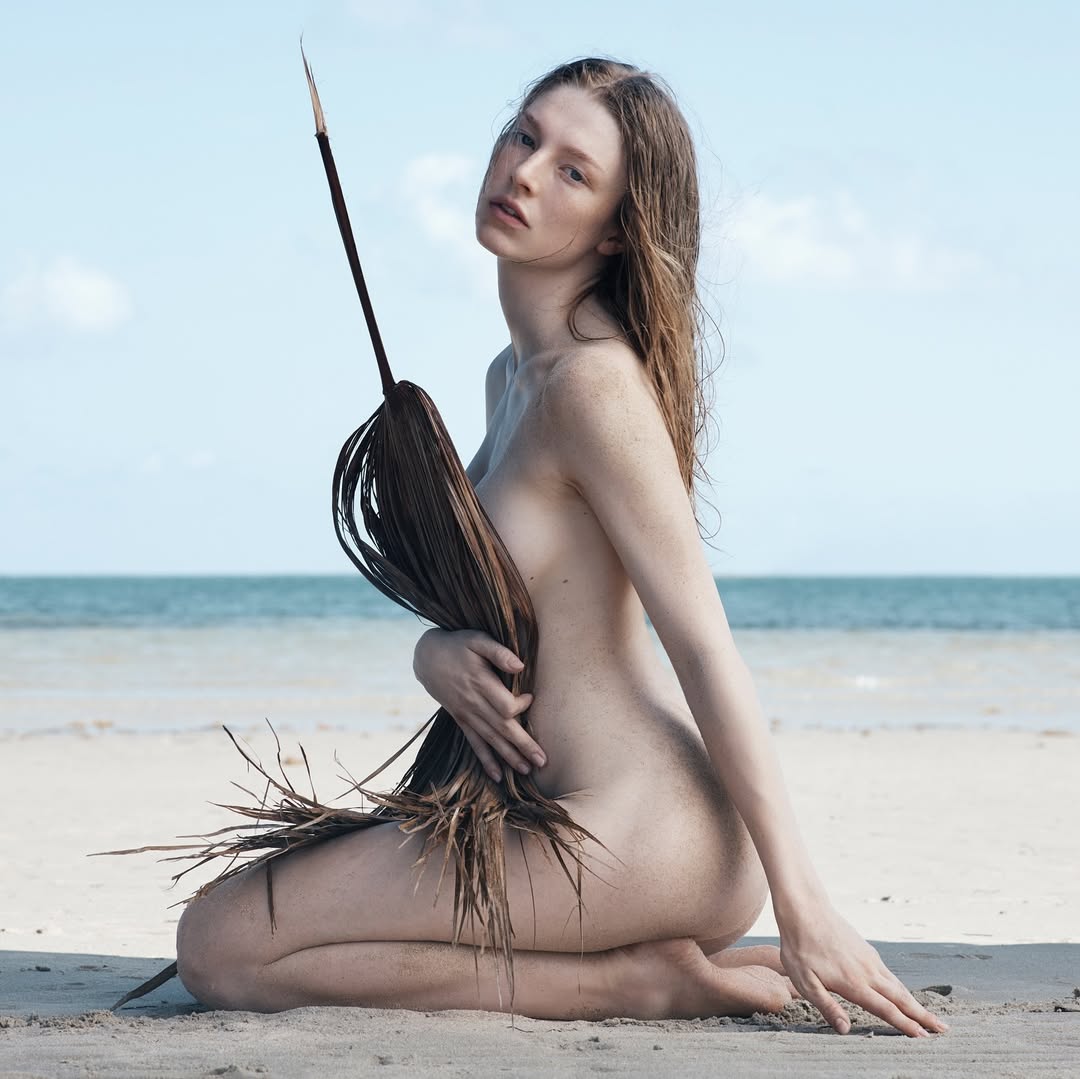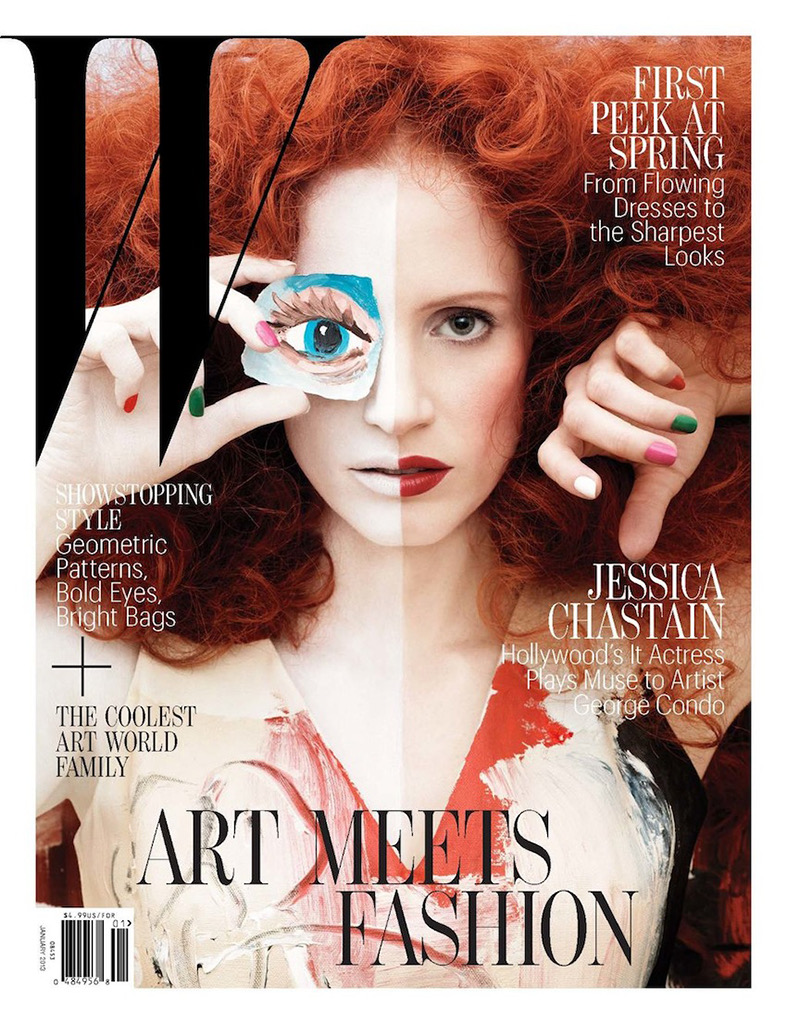
Amber Valletta by Peter Lindbergh | Image courtesy of MA + Group
A longtime industry veteran, make-up artist Fulvia Farolfi grew up a teenager more focused on sports than beauty, but creative curiosity tugged at her. Whether it was the shimmer of her gym teacher’s eyeliner or the rows of pigments in her neighbor’s makeshift salon upstairs, her interest was piqued from those early days. The turning point came when she encountered Irving Penn’s iconic Contact Lens photograph. Something about the intimacy and precision of that image stayed with her, leading her to trade science studies for beauty school in Milan. Eventually, Farolfi moved to New York with a singular mission: to work with the photographer who first sparked her path. After weeks of persistence and one fateful call to his studio, she got her chance. Years later, when she shared the story behind her journey, Penn told her, “You thanked me back today with your work.” Since then, she’s carved out a lasting space in the beauty world, collaborating with some of fashion’s top photographers—Peter Lindbergh, Inez and Vinoodh, and stylist Tonne Goodman among them—and serving as Chanel’s U.S. beauty ambassador since 2010. One longtime dream also came full circle when she was tapped as lead makeup artist for the 2025 Pirelli Calendar, shot by Ethan James Green. “We all agreed, Ethan, Tonne, and I—that beauty, in this context, meant comfort in your own skin,” she said. “It felt fresh, modern, and real. I was genuinely honored to be part of it.” Fresh off leading makeup for Max Mara’s Resort 2026 show in Caserta, Farolfi sat down with Models.com to reflect on the power of beauty, the elegance of imperfection, and the wildest moments she’s navigated on the job.

Linda Evangelista by Robin Galiegue | Image courtesy of MA + Group
What was your relationship to beauty growing up? I know you were really into sports. How did that shift into beauty?
I think I’ve been interested in beauty since my teenage years. We had a neighbor in our apartment building who was a beautician. She did waxing and had all these products and color palettes. I never did make up with her, but I was fascinated by it. Then I started experimenting with my mom’s products. I remember using this toner from Estée Lauder, probably packed with alcohol—and thinking, “Whoa.” I started noticing the effects of beauty products. I was studying science at the time, and when I decided to go to beauty school, my parents and friends were shocked. I thought, “Why not give it a try?” I ended up loving it, I’d watch people on the street, and I was just really curious. I bought my first eyeshadow palette from this brand, Diva, and when I saw an Italian Vogue cover originally published in American Vogue, I knew that this was what I wanted to do. It was that famous photo by Irving Penn of a model putting in contact lenses. The article was about colored lenses, but what struck me was how the makeup transformed the close-up; that’s when Penn became my idol.
After beauty school, did you move to New York?
I actually moved to Milan to go to makeup school first. Out of 90 students, I graduated top of the class, and they asked me to teach for a year. We studied everything—special effects, costume makeup, art history, and the meaning of makeup through the ages. We also learned what they called “corrective makeup” at the time, which is what people now call enhancement or sculpting, making eyes appear larger, defining features, that kind of thing. While teaching, I started freelancing. I tried one film job, but after three months and only two looks, I knew I’d get bored. That’s when I decided to pursue fashion instead. I still remember my early shoots in Milan—working with André Leon Talley, who was editing House & Garden when Anna Wintour was editor-in-chief, and Patrick Demarchelier shooting. That excitement made me want to try New York. Four years later, I moved there with just my portfolio. I thought I’d stay a month…I never left.
I know Irving Penn was a huge inspiration for you. What was the process of meeting and working with him like?
I came to New York with a list of photographers and agencies, but it was August 1989, and the whole industry had shut down for the summer. One agency wanted to sign me immediately, but something didn’t feel right. Another told me to come back in September once shows started up again. Almost a month in, I called Mr. Penn’s office. His assistant told me, “Mr. Penn doesn’t see portfolios. That’s not how it works. Call back in two weeks and send your card.” I called again a few weeks later. This time, his studio manager picked up and gave me the same line. I explained I didn’t want to bother him, I just wanted him to see my work. After about ten minutes, she said, “Fine—drop off your book tonight and come back in the morning.” When I returned, she said, “Mr. Penn loved your work. He’s in a meeting now.” We sat and talked, and I explained my background. I had worked with a well-known Italian photographer who shot beauty with zero retouching, using a Hasselblad. I didn’t have covers or fame, but the technical work and beauty were there. The studio then arranged a meeting for me with Maggie Buckley, the casting director at American Vogue. After reviewing my book, she picked up the phone and called Bryan Bantry, who was the biggest agent in New York at the time. She said, “Someone from Irving Penn’s studio is here. I think you should meet her.” Just like that, I got my agent. All within two months of moving.

By Raymond Meier | Image courtesy of MA + Group
When did you actually work with Penn?
Not for a few years. I needed to grow first. I was used to working with Italian editors and photographers, but I had to adjust to the language, the references, and the culture here. After about six months, I met a group of creatives who had recently moved from Milan to New York, like Fabien Baron and a few stylists. We were connected through my old agent. From there, I started meeting major names like Isabella Rossellini and art directors for Estée Lauder and Lancôme. I finally understood the vocabulary and beauty references that were expected. When I met Penn, he didn’t put me to work right away. First, he just wanted to observe me in the studio. No music, no distractions—just silence. He shot a photo with two girls, one in a lime wig, the other in orange, talking to each other. You couldn’t even see their faces. He just wanted to see how I behaved on set. The second time, I actually worked. We did a white base with chunks of color. I hadn’t done a white face since makeup school. It was sink or swim. For me, it felt like stepping on stage—I had to perform. He would come two inches behind me to inspect the work. Once he said, “Not too perfect, Michelangelo,” because he liked a bit of mess. He was an incredible character. I heard he made people cry, but only if they weren’t good. If you weren’t talented, you simply didn’t belong. It was brutal, but that was the ‘80s and ‘90s. After five shoots, when I felt I had proved myself, I told him the story of the photo that inspired me— the one of the model putting in a contact lens, and he said, “You thanked me back today with your work.”
Who were your beauty idols growing up, and what made them stand out to you?
One of my earliest memories is my high school gym teacher—she wore this shiny eyeliner that fascinated me. To this day, I wish I had asked her what brand it was. I think it was Shiseido, an old packaging maybe. It was liquid and stayed shiny, which is so rare. I’ve still never found anything quite like it. I’ve always been drawn to details like that. I love street trends and period makeup, whether it was Sophia Loren, Catherine Deneuve, Audrey Hepburn, or Barbra Streisand. It was so interesting to see how makeup evolved and reflected women’s roles in society. That’s something we even studied in school. But what inspires me most is what I see on the streets and in art. That’s where the real magic is for me.
Are there specific paintings that still inspire you today?
Picasso has always been a huge influence. I love shapes and color, and how versatile and expressive his work is. I also appreciate the precision of René Magritte, but equally, the imperfection in Picasso’s work. They’re both moving in different ways. To me, when makeup is done well, it’s like sculpture; it draws you in. It becomes a work of art. The best feeling is when someone says, “Oh my God, I’ve never felt so beautiful.” That’s the real reward. I remember working with Serena Williams maybe 15 years ago. She sent me the kindest note afterward. Moments like that—those are the things that really stay with you.

Hunter Schafer by Ethan James Green | Image courtesy of MA + Group
How did it feel to work on your first-ever Pirelli calendar, and how did you collaborate with Ethan James Green & Tonne Goodman to bring the looks to life?
I had just signed with my agent, Andy, maybe two months earlier. We were brainstorming about dream clients and projects, and I said, “You know what? One thing I’d love to do is the Pirelli calendar.” It’s iconic. I’ve always loved working on makeup that’s sexy and empowering, when a woman feels truly at her best. And then, three weeks later, the call came. I couldn’t believe it. It really felt like a manifestation moment. The team was incredible, Tonne Goodman styled it, and Ethan James Green photographed it. We all agreed that beauty, in this context, meant comfort in your own skin. There were two settings: one in the studio, one on the beach. Sometimes, the beach was the more sultry environment, and other times, it was the studio; it really depended on the energy. I loved the cast. The clients were a little nervous at first, but by the end, everyone had embraced it. It felt fresh, modern, and real. I was genuinely honored to be part of it.
You became Chanel’s U.S. beauty ambassador in 2010. Can you describe your relationship with Chanel and how you collaborate with them?
I think it happened through word of mouth. There were five of us in the running—four artists based in LA and me in New York. I believe they really responded to my editorial work and the way I would reference products in my shoots. From there, I started presenting collections to beauty editors in New York and attending the shows. Those were some really thrilling years. We went to some incredible shows by Karl Lagerfeld, and I am looking forward to the new chapter with Matthieu Blazy. Now, we do tutorials a few times a year, which is a lot of fun, sometimes with celebrities, sometimes with models. Technique-wise, my original teacher from back in the day was incredibly precise—ten times more so than anyone I’ve encountered since. I’m grateful for that foundation. But over time, I’ve let go of certain rules and made the techniques my own. You can’t stay stuck in one era, or it starts to look dated. Still, having that base has been invaluable.
So you’re saying you’ve taken those classic skills and evolved them into something personal. With Chanel, do you also help with product development or provide feedback?
Yes, definitely feedback. One of the great things is that we sometimes have conference calls with the other artists—there are more than five of us now—and we share thoughts on products. One example is the Les Beiges bronzer. It originally came in one big jar and was super orange. We all pushed for more inclusive shades, and now they’ve released three, which is a big improvement. We also regularly advocate for more neutral lip colors. The market often prefers pinks and reds, but from an artist’s perspective, we’re always hoping for more balance. It’s a collaboration; our feedback helps guide the product range, though final decisions are made by the main team in France. The three artists there develop the core collections, and we serve as the U.S. ambassadors.

Jessica Chastain by Max Vadukul | Image courtesy of MA + Group
What’s the craziest impromptu situation you’ve had to navigate on a job, and how did you handle it?
I’ve done makeup on a private plane while it was landing. I’ve had to rebuild an entire kit in a shopping mall in Sardinia in 20 minutes after the airline lost mine. I’ve worked in the Amazon, on glaciers in Patagonia, on a mountaintop in Switzerland, and on a frozen lake near the North Pole. I was lucky in Sardinia, I knew the area, so I had a sense of where I could find things quickly. It was a five-day job, and my bags didn’t arrive until day three. I built a makeshift kit with a range of foundations based on the models we were working with and just made it work.
Another time, we were shooting in Ghana with Naomi Campbell and Edward Enninful. At the end of the shoot, we were surrounded by what we thought was the police. It was on a university campus, and it was intense; even Naomi was nervous. They demanded the film, but of course, it wasn’t developed yet. It took us about 30 minutes to realize they weren’t real police but campus security. They wanted all the photos, which the assistants managed to hand over. Looking back, it wasn’t about money or corruption—it felt more like a power play. Then there are the elements. I’ve been caught in windstorms in the desert and skated across a frozen lake to do touch-ups. At the end of the day, you just adapt.
“The pursuit of perfection has become dominant, but perfection isn’t always the most interesting thing….You can find inspiration in so-called imperfections, too.”
Having been in the industry since the ‘90s, how have you seen it evolve? What are the main shifts you’ve observed, and are there any specific trends or changes that stand out to you?
The pace has changed dramatically. When I started, there was the luxury of time. Photographers like Penn would sketch the concept first, then take a month to cast, and only shoot once everything felt right. If one thing was off, he’d send everyone home. No compromise. It was the same with Newton, Avedon, Hiro; there was this patience, this reverence for the process. After the 2007 financial crisis, everything sped up. Fewer people were buying magazines, and suddenly, the number of images needed per day multiplied. References became a shortcut for teams who didn’t always have the knowledge or shared language. In terms of beauty, social media, especially TikTok has completely changed trends. The pursuit of perfection has become dominant. If a brow isn’t flawless, people feel like it’s wrong. Everything’s about symmetry, sharp lines, precision. And that’s fine, but perfection isn’t always the most interesting thing. What works for one face may not work for another, and not everyone knows how to see that. You can find inspiration in so-called imperfections, too.

Amelia Gray, Angelina Kendall, Anok Yai, Devyn Garcia, Loli Bahia, Lulu Tenney, Vittoria Ceretti, by Inez and Vinoodh | Image courtesy of MA + Group
After all these years, what’s something about your job that still excites you?
Meeting new talent. A new face, a surprising photographer—it always excites me. I’m a sucker for talent. When I see it, I light up.
As someone with so much experience, what advice would you give to young makeup artists trying to break into the industry?
Follow your instincts. There’s no single path in this business. For me, it was editorial, then advertising, then fashion. But I always say: take your time. Don’t rush into working with a big-name photographer before you’re ready. It’s better to build slowly so you have the skills and experience to back it up. That’s what gives you longevity. I designed color for Shiseido for five years and would go to Japan often in the early 2000s. I also worked with L’Oréal in Paris for Emporio Armani. Product development is another passion of mine, another way to channel creativity. What I notice today is that many young artists think like business people right away—and some do it brilliantly. I’m not wired that way. I work from the heart. I do fine, but I’ve always known my limits, and that’s okay. I’ve focused on other parts of life too. If you’re like me, surround yourself with people who can fill in the gaps—a great accountant, a great lawyer. And if you’re someone like Pat McGrath, who is both incredibly creative and business-savvy? Amazing. But even if you’re not, knowing your strengths and building the right team can take you far.








